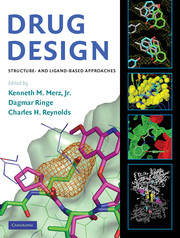Book contents
- Frontmatter
- Contents
- Contributors
- Preface
- DRUG DESIGN
- 1 Progress and issues for computationally guided lead discovery and optimization
- PART I STRUCTURAL BIOLOGY
- PART II COMPUTATIONAL CHEMISTRY METHODOLOGY
- PART III APPLICATIONS TO DRUG DISCOVERY
- 12 Computer-aided drug design: a practical guide to protein-structure-based modeling
- 13 Structure-based drug design case study: p38
- 14 Structure-based design of novel P2-P4 macrocyclic inhibitors of hepatitis C NS3/4A protease
- 15 Purine nucleoside phosphorylases as targets for transition-state analog design
- 16 GPCR 3D modeling
- 17 Structure-based design of potent glycogen phosphorylase inhibitors
- Index
- References
16 - GPCR 3D modeling
from PART III - APPLICATIONS TO DRUG DISCOVERY
Published online by Cambridge University Press: 06 July 2010
- Frontmatter
- Contents
- Contributors
- Preface
- DRUG DESIGN
- 1 Progress and issues for computationally guided lead discovery and optimization
- PART I STRUCTURAL BIOLOGY
- PART II COMPUTATIONAL CHEMISTRY METHODOLOGY
- PART III APPLICATIONS TO DRUG DISCOVERY
- 12 Computer-aided drug design: a practical guide to protein-structure-based modeling
- 13 Structure-based drug design case study: p38
- 14 Structure-based design of novel P2-P4 macrocyclic inhibitors of hepatitis C NS3/4A protease
- 15 Purine nucleoside phosphorylases as targets for transition-state analog design
- 16 GPCR 3D modeling
- 17 Structure-based design of potent glycogen phosphorylase inhibitors
- Index
- References
Summary
INTRODUCTION
G-protein-coupled receptors (GPCRs) are a superfamily of membrane proteins that provide cells with the ability to communicate with each other and their environment. The core feature of these proteins is their seven transmembrane helices (7TM) that form a bundle located in the cell membrane (Figure 16.1). The seven helices are linked together by three extracellular loops (ECLs) and three intracellular loops (ICLs) and also include N- and C-terminal regions. This 7TM region is responsible for receiving a wide range of signals from small-molecule amines, peptides, proteins, small odorant and taste molecules, and light, which either bind in the interior of the 7TM bundle or to its extracellular surface or interact with chromophores located in its interior. These external signals trigger the coupling of the ICLs (in particular ICL5) with the heterotrimeric G-protein transducin, which in turn initiates a cascade of signaling events that lead to proliferation, differentiation, development, cell survival, angiogenesis, and hypertrophy. In light of these facts it is not surprising to find that GPCRs are implicated as targets in a wide range of indications, including heart disease, allergies, depression, mental illness, cognition, and hypertension.
The estimated number of GPCRs in humans is ∼1,000 members or ∼1% of the genome. There are five major classes of GPCRs that are defined by their sequence homology and the type of endogenous ligand. The most important of these classes are A, B, and C. GPCRs are dysfunctional or dysregulated in many diseases making them the target of drug therapies.
- Type
- Chapter
- Information
- Drug DesignStructure- and Ligand-Based Approaches, pp. 248 - 256Publisher: Cambridge University PressPrint publication year: 2010



